Power up your plant-based protein

Consumer demand for plant-based protein products in the sports nutrition market is continuing to boom and market growth is showing no signs of abating. Social media is abuzz too!
Last year, over 20 million Instagram posts on plant protein products alone captured the imagination of many.
According to Innova, 16% of all sports nutrition new product launches in 2018 used plant-based ingredients. The graph below, taken from Mintel tracks plant-based performance nutrition NPD over the last 5 years:
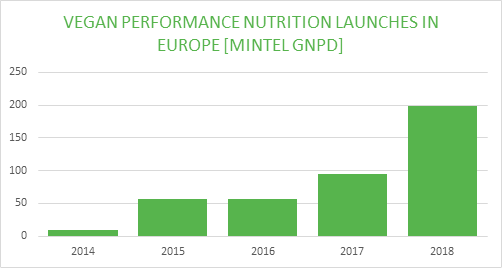
Additionally, Innova market insights data shows over 40% growth in new sports nutrition launches with a plant-based claim between 2014 and 2018.
It’s safe to say that what we’re seeing is far beyond just a fad, especially given the brands now operating in this space.
In the past year high-profile vegan launches from traditional milk protein based nutrition brands have hit the market:
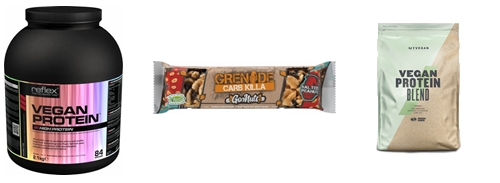
As this market moves towards mainstream appeal, consumers have become more discerning. Mintel data shows that 52% of US consumers say that ‘taste’ is the most important factor when choosing a plant-based protein. Considering the inherant taste challenges related to plant-based proteins, brands are now having to strive harder than ever to meet these demands.
Plant-based protein – paired to perfection
Whether you are looking to optimise your core profiles or launch new to category flavours, we have developed a five-step process that overcomes the challenges associated with flavouring high protein plant-based applications
Synergy 5-step approach
In order to deliver the optimum flavour solution for plant based protein sports nutrition products, we have adopted a 5 step process that we use in development.

We understand that plant-based proteins have a very different composition to dairy proteins. As with any natural product, depending on environmental conditions, harvesting and storage, their flavour profile varies considerably. In vegan blended products, the exact ratio of each protein can influence the inherent flavour of the product base.
Many consumers find plant-based protein unpalatable and flavours that work well with dairy protein don’t necessarily work well with these alternative bases.
In order to deliver the right flavour or flavour combination that masks the inherent off-notes of the protein base, it is crucial that the off-notes of the base are characterised and understood.
At Synergy, we have invested substantially in analytical capabilities to understand the off-notes in a range of alternative vegan proteins and have recently completed a project characterising pea, brown rice, hemp and pumpkin proteins.
Step 1: Descriptive analysis
We use analysis by a trained panel to identify the sensory characteristics of the protein base. We then review the sensory data with the analytical data, and this acts as a guide for our flavourists to develop tailored solutions.
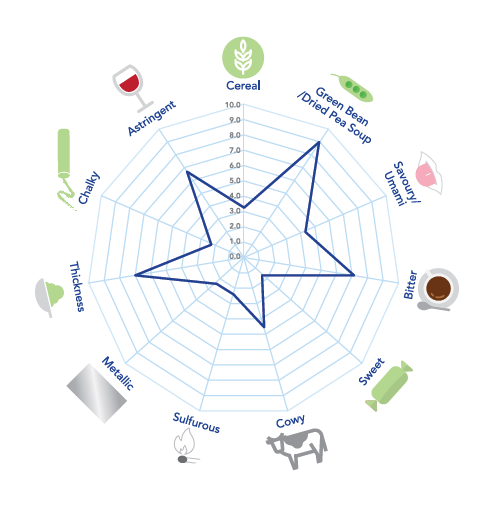
The sensory profile of a typical pea protein
Step 2: GC-MS and GC-O
Gas Chromatography-Mass Spectrometry (GC-MS) is an analytical technique that allows the separation and identification of flavour compounds within the sample. The resulting chromatogram (a timeline graph with a number of peaks) depicts all the volatile compounds within the sample – in many ways it functions as a fingerprint for the flavour.
Unfortunately, not all of these compounds are relevant to the flavour profile, which is why Gas Chromatography-Olfactometry (GC-O) is used. GC-O uses the same process, except with the input of a human assessors. Trained assessors will smell the aroma emitted as the sample passes through the GC and identify odorants and their intensity as they detect them. The result is another timeline graph called on Olfactogram.
By using this technique, our analysts can overlay the Chromatogram with the Olfactogram and plot which compounds produce which aromas and at what levels of intensity. By understanding the key odorants in plant-based proteins, we can select or tailor flavours specifically for this base.

Step 3: Flavour pairing
When different foods share key aromas, they are more likely to work well together. Once the key odorants in a protein ingredient have been identified, flavour pairing combinations that contain some of the same odorants can be selected.
A good example of flavour pairing is Nutella chocolate spread. The reason Nutella works so well is because it’s two key ingredients (hazelnut and cocoa) both share key aroma compounds which give roasted notes and cocoa notes.
From our initial analysis, we have also learnt that typical core sports nutrition flavours such as chocolate, strawberry and vanilla – are not the best fit for plant-based proteins due to the inherent notes found in different plant-based sources. Many manufacturers try to get around this through higher dose rates. This is not only inefficient, but rarely delivers the desired profile. To solve this, our flavour creation team has used analytical data to redesign these core profiles and accentuate notes which complement plant-based proteins. They have done this by working with the key volatiles in each protein source and adapting the core flavour profiles to work with the alternative protein base
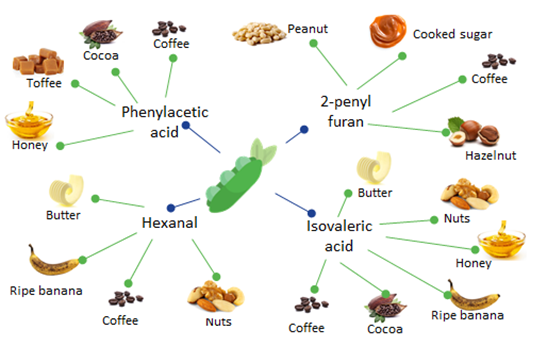
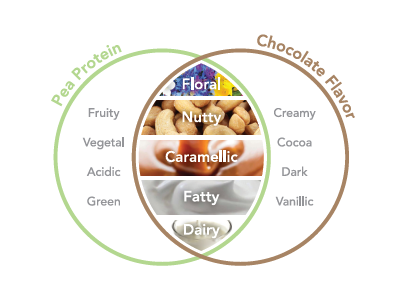
A perfect example of this would be a chocolate flavour used on a pea protein base. As the diagrams above show – the two are not naturally compatible, with only a handful of common aroma compounds. Using this data, we could identify the need for a chocolate flavour with particularly enhanced cocoa notes which could counterbalance the base and give the desired chocolate profile.
Using this method, our core profiles for plant-based proteins have therefore been specifically designed to enhance desirable notes within the base and subdue undesirable ones.
This approach has led us to develop a range of core flavour profiles such as chocolate, strawberry and vanilla, which pair well with plant-based proteins. Understanding the plant-based protein profiles has driven knowledge of how best to flavour them and our work demonstrates the importance of understanding a complete food matrix and tailoring flavours to achieve a synergistic solution.
Our approach has enabled the development of not just tailored core flavours such as chocolate, strawberry and vanilla for plant-based proteins, but also a range of exciting, innovative flavours such as Coffee Caramel, Caramel Apple, Banana Spice and Gingerbread to appeal to more adventurous consumers.
Step 4: Applications creation
By understanding plant-based protein profiles, we have been able to build our knowledge and understanding of how best to flavour them and our work demonstrates the importance of understanding a food matrix and tailoring flavours to complement it to achieve a synergistic solution.
We have been able to apply these learnings to key plant-based protein application types including ready to mix powders, ready to drink beverages, bars and snacks.
Step 5: Sensory validation
As our process began, so too does it end with sensory – our team of experts evaluate the range of flavours in order to verify that the flavour level is appropriate and, not only meets, but exceeds all expectations to deliver a consumer preferred product to market.
Looking ahead – what’s coming up?
As the market for plant-based proteins continues to evolve, we will continue to apply our 5-step process to develop effective flavour solutions for other challenging plant-based protein bases. We predict that the next wave of plant-proteins will include bases made up of ingredients such as collagen, sunflower and quinoa we will be ready with flavour solutions to the challenges that these may bring.
Are you looking to tap into a new market by launching a plant-based protein product? Or looking to improve your current range? Speak to our team to find out more about how our unique approach can help you overcome any flavour challenge! Alternatively you can read our brochure on our plant-based protein solutions
insights
